The exhibition budgerigar of today is far removed
from its wild cousin in the Australian Outback, but we must ask the question
if our general husbandry practices and cafeteria style feeding are having a
negative impact on the natural instincts of the birds in our studs.

Several years ago during one of my regular chats with Eric Peake we discussed a presentation by Rosemary Low at the "Think Parrots" convention in London. The topic of Rosemary's talk was the importance of foraging or fossicking for food by ground feeders like budgerigars, cockatiels, etc, and its role in stimulating the natural instincts of the bird.
Ground feeding parrots like budgerigars are deep diggers .This stimulates the brain towards survival.
A key factor of captive breeding, as we do with budgerigars, is that we go in direct opposite to the wild aspect of bird community relations.
Budgies are group feeding birds,and have the ability to share danger and location of food with communal contact when in a mass or flock.
Budgies are also by nature a very active bird. They are ground feeders and foragers, and get plenty of exercise. In the wild they leave the trees and nests in the early morning and fly to areas where there is abundant seeding grasses, frequently 40-50 kilometers away.
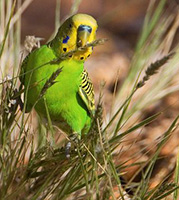
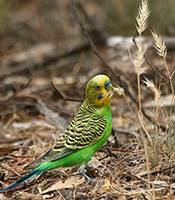
On reaching the feeding grounds they forage, first eating the green seed heads, then they fossick around on the ground for dried seed. When crops are full they return to the nests to feed youngsters or perch in the trees during the heat of the day. During the afternoon they forage again, and later take refuge in the trees as the sun begins to set.
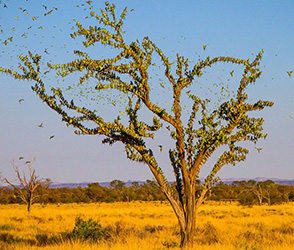
In the wild it's survival of the fittest. Not only do the birds have to avoid their natural predators... eagles, hawks, nest raiding butcher birds, snakes, goanas, dingoes and ferral cats.. but the constant search for food demands that they are fit and healthy, or they will not survive.
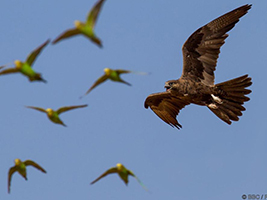
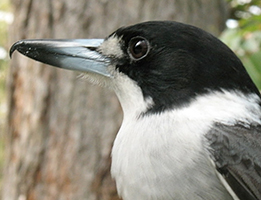
Hawks attack flocks in flight. Butcher birds raid nests killing chicks.


On the ground goannas and snakes are waiting.
Only the fit survive, and research in the outback shows the wild budgies have a good lifespan, and, depending on the season and availability of feed, raise at least a couple of nests of healthy chicks each year, so fertility is high too.
Conclusions from the presentation and associated long term research: Staying as close to nature as possible with foraging/fossicking being an integral element in aviary management has a direct relationship with activity, health, fertility and breeding production of budgerigars and other ground feeding birds.
Now let's take a look at how we manage our birdroom.
Flight cages seeem to be getting smaller and smaller which severely limits the activity and exercise the birds get. Exercise is an essential element in the health of the birds and physical development of youngsters.
In the majority of cases seed is provided in dishes or bowls. Husks are removed, blown off, and new seed added on a daily basis. The birds sit on the side of the bowl to eat and do not have to work (fossick or burrow down through husks) to access all the seeds they need. Somewhat similar to eating hamburger and fries at a table in McDonalds for every meal, yet we wonder why some birds seem prone to put on extra weight (fat).


Individual seed dishes for one bird, or a pair, does not give the bird brain decisions that need to go with communal feeding.
The seed bowls are located just inches from the perch in the breeding cages, and in some cases on elevated tables or platforms in the flight to keep them off the floor. Virtually no activity, ie exercise, is required to get to the cafeteria feeding.
Any seed that in not eaten after several days is disposed of. The birds have eaten their favorites which usually includes the oats and other calorie laden grains, and those which are less to their taste but may be more nutritious are thrown out with the trash.
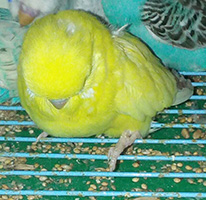
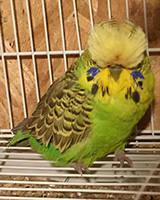

In many cases breeders use cages with wire bottoms so any spilled seed and husks fall to a removeable tray.
These wire bases eliminate the ability to fossick through seed the birds cannot reach, and in the case of youngsters they do not learn to forage or fossick naturally. And again good fresh seed that falls through the bottom wire grid is often thrown out with the trash.
We also ignore the "survival of the fittest" theology. In most cases, when a bird is off color or showing signs it is not well, we guess as to the cause and administer medications of choice in the hope they will save the bird.
Experience tells us that some birds are less robust than others and these are prone to minor infections that in the wild would be their demise, yet we fight to keep them alive knowing that any bird that has been seriously ill rarely, if ever, returns to top health and vitality.
If a bird is off color far better to attempt natural remedies to help it rebound, rather than medications which tend to strip the gut of all desireable flora and leaving it with virtually no natural immunity to fight off infections.
Making A Few Changes To Test The Theory
Being someone who always tries to stick as close as possible to nature I decided to make a few changes and monitor the results.
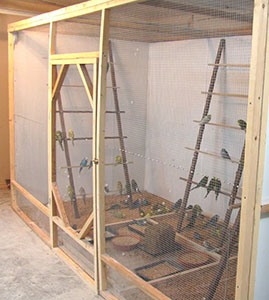
When not breeding my birds are kept in a walk-in flight 10 ft x 6 ft x 7 ft high with moveable ladder perches positioned to allow plenty of exercise flying up, down and across the flight.
The floor of the flight cage is divided into sections using 4" x 2" wood. The three sections under the perches are covered with chopped timothy hay which is replenished as needed every 2-3 weeks.
The timothy hay contains a little molasses which is used to bind it together in bales for packaging.
The birds forage through the new chopped timothy hay when it is added, soon gnawing it down to a "powdery dust" that is easily swept up before a fresh supply is added. Not sure what they are after but there is obviously something they crave as they spend days gnawing on it and grinding it down.
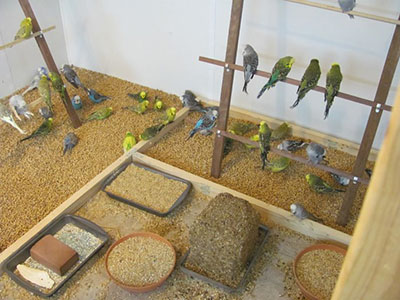
Large dishes and trays containing seed, grit, and dry supplements were set in the center section of the vinyl tile floor inside the door, so the birds must fly down to "the ground" to eat. In the past the dishes and trays were topped up every couple of days so seed was readily accessable to the birds, and towards the end of the week any uneaten seed was disposed of. (Most weeks a good amount of husks and seed went in the trash).
The major change made related to seed. At the beginning of each week large, deep plastic trays were filled with fresh seed.
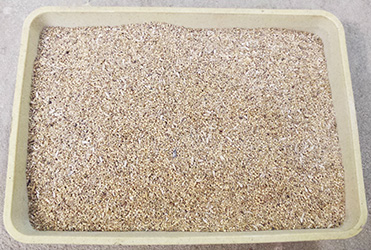
The new "deeper" plastic feed trays, 5 inches in depth, are filled with fresh seed at the beginning of each week for the birds to forage through.
As more of the seed was consumed husks accumulated at the top and uneaten seeds dropped lower in the tray. The birds would then dig down through the husks to find uneaten grains, moving their heads from side to side to move the husks aside as they fossicked lower.
No budgie will eat contaminated seed, only the clean seed,They test with the tongue prior to shelling the seed.
After a few days trays were checked to confirm there were uneaten seed towards the bottom, so I was sure there was food available if they "worked" to find it.
At the end of the week all dishes and trays were emptied onto the floor, Husks and uneaten seed, grit and any dry supplement that remained. Dishes and trays were removed, and during the day the only source of food was the "left-overs" on the floor.
The birds foraged through the leftovers, eating anything they had missed in the dishes, which was now much easier to find spread out over the floor.
By feeding in large deep plastic trays they are in a similar state as in the wild. By topping up the trays once a week then scattering the remaining seed at the end of the week the fossicking stimulates their brain to function,
At the end of the day the husks and anything remaining on the floor was removed. One observation was that very little seed was left at the end of this day..... which translated to a savings on seed costs. 99% was now being eaten instead of a large portion ending up as trash.
The deep plastic seed trays were then filled and returned... and the process started again.
After just a few weeks it was interesting to note that most birds preferred to fossick through seed spilled on the floor rather than sit on the side of a dish and gorge themselves with seed without working for it.
The birds were definitely more active. As in the wild, they spent the majority of each day foraging and fossicking through the seed and timothy hay on the floor, returning to the perches for quiet time early afternoon and again as the lights dimmed at the end of the day.
Activity between the sexes also seemed more intense, especially when pick blocks, branches, and seeding grasses were added.
The overall health of the birds also appeared to be improved. It was rare to see a bird off-color even during heavy moults or when there were extreme weather changes.
Breeding season: The hens were anxious to breed. Most were exploring the nestbox within hours of pairing up, and started laying within 10-14 days.
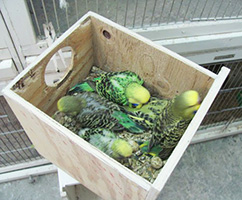

Fertility and hatchability have been excellent since the changes.
Breeding pairs again preferred to fossick through seed spilled on the floor of the breeding cage, rather than sitting on the side of the seed dish.
Another trend was for youngsters in the flight to develop and muscle up faster than in previous years (but that could have been more to do with disposal of middle of the road stock prior to breeding season).
Conclusions:
It is too early to reach any final conclusions after only 18 months using these methods. However it would appear that the overall health, vitality, fertility and production in the breeding cage has improved, along with a substantial savings in seed costs.
It will take several more years to confirm if the improvements were a result of the foraging and fossicking stimulating the natural instincts of the birds.
So far results are very pleasing. Maybe something for others to consider.
Special Thanks to Rosemary Low and Eric Peake for sharing their experience and knowledge in helping us to understand the impact we have on the natural instincts of our birds.
